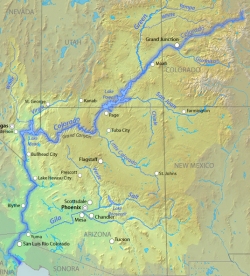
October Editorial
Ancient Colorado River flowed in the opposite direction to its modern counterpart.

October Editorial
Ancient Colorado River flowed in the opposite direction to its modern counterpart.
|
The Colorado river, is one of the longest rivers in the USA. It starts in the Rocky Mountains of northern Colorado, and from there begins a 1450 mile (2330 km) journey to the sea. The river flows through Utah, Arizona and Nevada before reaching California and emptying into the Gulf of California between the Baja California peninsula and mainland Mexico.
|
However, this was not always the case. Recent studies from the Department of Global Ecology at the Carnegie Institution at Palo Alto, show that some 55 million years ago a river, which was probably as large as the present Colorado river, flowed in the opposite direction - from California through Arizona to Utah. The researchers believe that the source of this ancient river was in the Majove region of southern California. For this reason they have named the ancient river the California River. (Though the Odaroloc might have been a better choice.) |
Steven Davis, post-doctoral fellow at the Carnegie Institution, and his colleagues discovered the ancient river system by comparing the composition of sedimentary deposits collected in Utah and southwest Arizona. These deposits were examined by uranium-lead (U-Pb) dating techniques. The deposits contained sand grains with zircon. Because radioactive uranium in the zircon decays to lead, by estimating the uranium-to-lead ratio, the age of a particular deposit could be estimated.
Zircons are often used in dating techniques because they are very durable. They can survive most geologic processes, including erosion, transport, and even high-grade metamorphism. A very useful property of zircons is their ability to substitute a zirconium atom for another high-field-strength element, in this case, uranium (U). Because zircons always contain traces of uranium they can be used in U-Pb radiometric dating. Also, because Zircon does not naturally incorporate lead atoms into its structure, it can be assumed that the lead (Pb) content in Zircon is the product of uranium decay. By measuring the half-life of uranium and the amount of lead in the Zircon crystals, one can estimate the age of the zircon very precisely.
The sand samples collected in Utah and Arizona showed the authors of this latest research that the samples were statistically indistinguishable and were also identical to the composition of igneous bedrock in the Mojave region of southern California. The authors believe that this establishes the Mojave region as the source of the ancient river. From there the California river probably flowed northeast for about 700 km, finishing its journey in the Uinta Basin. (This basin is in eastern Utah, east of the Wasatch Mountains and south of the Uinta mountains.)
The ancient California River probably ceased to be as the Rocky Mountains rose and the northern Colorado Plateau tilted. This reversed the slope of the land and the direction of the riverís flow to create the present Colorado-Green River system. However, Davis and his colleagues have not determined precisely when the change occurred. "The river could have persisted for as long as 20 million years before the topography shifted enough to reverse its flow," Davis explains.
Reference
Steven J Davis, William R. Dickinson, George E. Gehrels, Jon E. Spencer, Timothy F. Lawton and Alan R. Carroll. The Paleogene California River: Evidence of Mojave-Uinta paleodrainage from U-Pb ages of detrital zircons. (2010) Geology, vol 38, 931-934.
| _______________________________ | ||||
| Home | | | Shopping | | | Database |
© Biscuit Software 2004-2015
All rights reserved